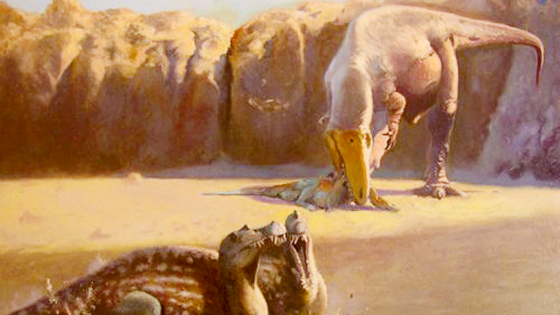New dinosaur named after SAURON from ‘Lord of the Rings.’
Hell yeah! While it isn’t exactly the embodiment of the Evil like his character in LOTR, a dinosaur is a pretty menacing thing to hang the name Sauron on.
I Heart Chaos:
Earlier this years, paleontologists came upon a 95 year old skull fragment that they later concluded didn’t belong to any known dinosaur species. This new species, a relative of Allosaurus, was named “Sauron” after the evil demonic character from Lord of the Rings.
It’s full name is Sauroniops pachytholus, a massive bipedal carcharodontosaur that lived during the Cretaceous period. The paleontologists, Andrea Cau, Fabio Dalla Vecchia, and Matteo Fabbri, felt that the single fragment provided enough evidence to warrant the classification of an entirely new species, and their work describing the new dinosaur has since been published in Acta Palaeontologica Polonica.
Interestingly, the discovery now adds credence to the hypothesis that a fourth large theropod existed in the Cenomanian of Morocco together with Carcharodontosaurus, Deltadromeus, and Spinosaurus (yes, all four of them at the same time — must have been a nice place to visit).
Unfortunately, however, the limited bone fragment reveals achingly little about Sauron. That said, the researchers speculate that it was more than 30 feet in length, and that it was probably just as large as the Carcharodontosaurus. The palaeontologists are obviously hoping to find more fossils to be absolutely sure.
There’s also the prominent bump on its head. Brian Switek from Smithsonian offers some theories as to its function:
Why did such a large theropod have a prominent bump on its head? In other theropod lineages, such as the abelisaurids, bumps, knobs and horns are common forms of ornamentation. Perhaps the same was true for Sauroniops–thanks to Acrocanthosaurus and the sail-backed Concavenator, we know that carcharodontosaurs showed off with visual signals. Then again, Cau and coauthors speculate that the dome might have been a sexual signal or might have even been used in head-butting behavior. I think the last hypothesis is unlikely, especially since we don’t know what the microstructure of the dome looks like and there’s no evidence of pathology, but it’s still a distant possibility.




